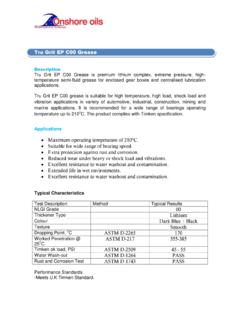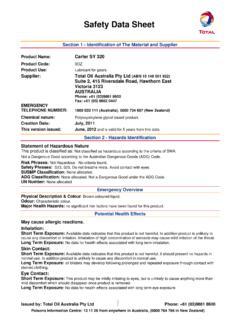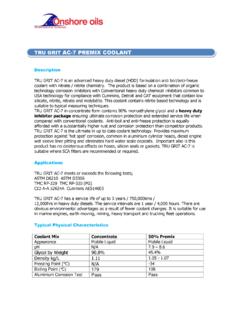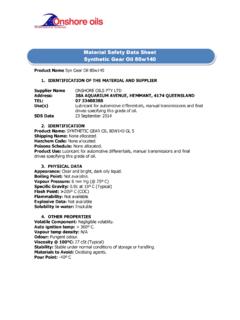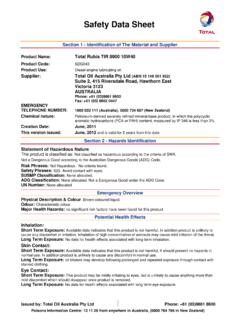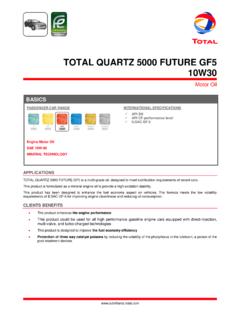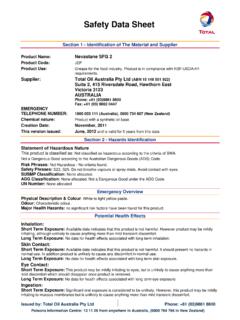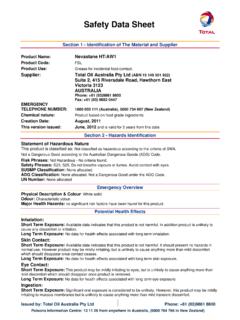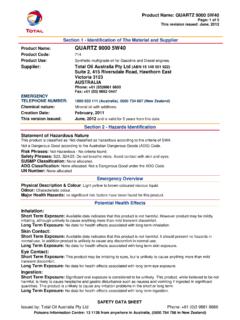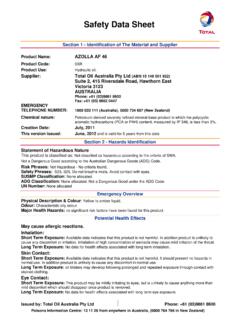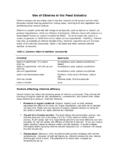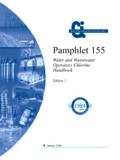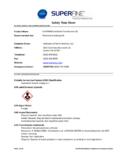Transcription of Material Safety Data Sheet TRU GRIT AC-70 Tar & …
1 Material Safety data Sheet TRU GRIT AC-70 Tar & Bitumen Remover Section 1 Chemical Product and Company Identification PRODUCT NAME TRU GRIT AC-70 [TRU GRIT AC-70 TAR & BITUMEN REMOVER][TRU GRIT AC-70 Tar & Bitumen Remover] SYNONYMS " AC-70 Bitumen Cleaner & Tar Remover" PROPER SHIPPING NAME HYDROCARBONS, LIQUID, (contains naphtha, petroleum, hydrodesulfurised heavy) PRODUCT USE Used according to manufacturer's directions. Bitumen cleaner; tar remover. SUPPLIER Company: ONSHORE OILS PTY LTD Address: 38a Aquarium Ave, Hemmant QLD, 4174 Australia Telephone: +61 7 3348 8388 Fax: +61 7 3390 7455 Section 2 - Hazards Identification STATEMENT OF HAZARDOUS NATURE HAZARDOUS SUBSTANCE. DANGEROUS GOODS. According to NOHSC Criteria, and ADG Code. CHEMWATCH HAZARD RATINGS Flammability Toxicity Body Contact Reactivity Chronic Scale: Min/Nil=0 Low=1 Moderate=2 High=3 Extreme=4 RISK Safety o Flammable o Toxic to aquatic organism, may cause long-term adverse effects in the aquatic environment o HARMFUL May cause lung damage if swallowed o Repeated exposure may cause skin dryness and cracking o Vapours may cause drowsiness and dizziness o Inhalation, skin contact and/or ingestion may produce health damage* o Cumulative effects may result following exposure* o May produce discomfort of the eyes respiratory tract and skin* o Limited evidence of carcinogenic effect* o May be harmful to the foetus/embryo* *(Limited evidence)
2 O Do not breath gas/fumes/vapour/spray o Avoid contact with skin o Avoid contact with eyes o Wear suitable protective clothing o Wear suitable gloves o Wear eye/face protection o Use only in well ventilated areas o Keep container in well ventilated place o Avoid exposure obtain special instructions before use o Do not empty into drains o To clean the floor and all objects contaminated by this Material , use water and detergent o Keep container tightly closed o This Material and its container must be disposed of in a safe way o Keep away from food, drink and animal feeding stuffs o In case of contact with eyes, rinse with plenty of water and contact Doctor or Poisons Information Centre o If swallowed, IMMEDIATELY contact Doctor or Poisons Information Centre (Show the container or label) o Use appropriate container to avoid environmental contamination o Avoid release to the environment.
3 Refer to special instruction/ Safety data sheets o This Material and its container must be disposed of as hazardous waste Section 3 - Composition /Information on Ingredients NAME CAS RN % naphtha, petroleum, hydrodesulfurised heavy 64742-82-1. <75 additive(s) <20 dye <1 water 7732-18-5 balance Section 4- First Aid Measures SWALLOWED If swallowed do NOT induce vomiting. If vomiting occurs, lean patient forward or place on left side (head-down position, if possible) to maintain open airway and prevent aspiration. Observe the patient carefully. Never give liquid to a person showing signs of being sleepy or with reduced awareness; becoming unconscious. Avoid giving milk or oils. Avoid giving alcohol. If spontaneous vomiting appears imminent or occurs, hold patient's head down, lower than their hips to help avoid possible aspiration of vomitus. EYE If this product comes in contact with the eyes: Wash out immediately with fresh running water.
4 Ensure complete irrigation of the eye by keeping eyelids apart and away from eye and moving the eyelids by occasionally lifting the upper and lower lids. Seek medical attention without delay; if pain persists or recurs seek medical attention. Removal of contact lenses after an eye injury should only be undertaken by skilled personnel. SKIN If skin contact occurs: Immediately remove all contaminated clothing, including footwear. Flush skin and hair with running water (and soap if available). Seek medical attention in event of irritation. INHALED If fumes or combustion products are inhaled remove from contaminated area. Lay patient down. Keep warm and rested. Prostheses such as false teeth, which may block airway, should be removed, where possible, prior to initiating first aid procedures. Apply artificial respiration if not breathing, preferably with a demand valve resuscitator, bag-valve mask device, or pocket mask as trained.
5 Perform CPR if necessary. NOTES TO PHYSICIAN Any Material aspirated during vomiting may produce lung injury. Therefore emesis should not be induced mechanically or pharmacologically. For acute or short term repeated exposures to petroleum distillates or related hydrocarbons: o Primary threat to life, from pure petroleum distillate ingestion and/or inhalation, is respiratory failure. o Patients should be quickly evaluated for signs of respiratory distress ( cyanosis, tachypnoea, intercostal retraction, obtundation) and given oxygen. Patients with inadequate tidal volumes or poor arterial blood gases (pO2 50 mm Hg) should be intubated. o Arrhythmias complicate some hydrocarbon ingestion and/or inhalation and electrocardiographic evidence of myocardial injury has been reported; intravenous lines and cardiac monitors should be established in obviously symptomatic patients. The lungs excrete inhaled solvents, so that hyperventilation improves clearance.
6 O A chest x-ray should be taken immediately after stabilisation of breathing and circulation to document aspiration and detect the presence of pneumothorax. Section 5 - Fire Fighting Measures EXTINGUISHING MEDIA o Water spray or fog. o Alcohol stable foam. o Dry chemical powder. o Carbon dioxide. FIRE FIGHTING o Alert Fire Brigade and tell them location and nature of hazard. o May be violently or explosively reactive. o Wear breathing apparatus plus protective gloves. o Prevent, by any means available, spillage from entering drains or water course. FIRE/EXPLOSION HAZARD o Liquid and vapour are flammable. o Moderate fire hazard when exposed to heat or flame. o Vapour forms an explosive mixture with air. o Moderate explosion hazard when exposed to heat or flame. o Combustion products include: carbon monoxide (CO), carbon dioxide (CO2), other pyrolysis products typical of burning organic Material .
7 FIRE INCOMPATIBILITY Avoid contamination with oxidising agents nitrates, oxidising acids, chlorine bleaches, pool chlorine etc. as ignition may result. HAZCHEM 3Y Personal Protective Equipment Breathing apparatus. Chemical splash suit. Section 6 - Accidental Release Measures MINOR SPILLS o Remove all ignition sources. o Clean up all spills immediately. o Avoid breathing vapours and contact with skin and eyes. o Control personal contact by using protective equipment. MAJOR SPILLS o Clear area of personnel and move upwind. o Alert Fire Brigade and tell them location and nature of hazard. o May be violently or explosively reactive. o Wear breathing apparatus plus protective gloves. Personal Protective Equipment advice is contained in Section 8 of the MSDS. Section 7 - Handling and Storage PROCEDURE FOR HANDLING o Containers, even those that have been emptied, may contain explosive vapours.
8 O Do NOT cut, drill, grind, weld or perform similar operations on or near containers. o DO NOT allow clothing wet with Material to stay in contact with skin. o Electrostatic discharge may be generated during pumping - this may result in fire. o Ensure electrical continuity by bonding and grounding (earthing) all equipment. o Restrict line velocity during pumping in order to avoid generation of electrostatic discharge (<=1 m/sec until fill pipe submerged to twice its diameter, then <= 7 m/sec). o Avoid splash filling. o Avoid all personal contact, including inhalation. o Wear protective clothing when risk of overexposure occurs. o Use in a well-ventilated area. o Prevent concentration in hollows and sumps. SUITABLE CONTAINER o Packing as supplied by manufacturer. o Plastic containers may only be used if approved for flammable liquid. o Check that containers are clearly labelled and free from leaks.
9 O For low viscosity materials (i) : Drums and jerry cans must be of the non-removable head type. (ii) : Where a can is to be used as an inner package, the can must have a screwed enclosure. o For materials with a viscosity of at least 2680 cSt. (23 deg. C) o For manufactured product having a viscosity of at least 250 cSt. (23 deg. C) o Manufactured product that requires stirring before use and having a viscosity of at least 20 cSt (25 deg. C). STORAGE INCOMPATIBILITY Avoid reaction with oxidising agents. Strong acids. STORAGE REQUIREMENTS o Store in original containers in approved flammable liquid storage area. o Store away from incompatible materials in a cool, dry, well-ventilated area. o DO NOT store in pits, depressions, basements or areas where vapours may be trapped. o No smoking, naked lights, heat or ignition sources. Section 8 - Exposure Controls/personal Protection EXPOSURE CONTROLS Source Material TWA ppm TWA mg/m STWL ppm STEL mg/m Peak ppm Peak mg/m TWA F/CC Notes Australia naphtha, 790 (See Exposure Standards petroleum, hydrodesulfurised heavy (White spirits) Chapter 16) The following materials had no OELs on our records Water CAS:7732- 18- 51 PERSONAL PROTECTION RESPIRATOR Type A Filter of sufficient capacity.
10 (AS/NZS 1716 & 1715, EN 143:2000 & 149:2001, ANSI Z88 or national equivalent) EYE o Safety glasses with side shields. o Chemical goggles. o Contact lenses may pose a special hazard; soft contact lenses may absorb and concentrate irritants. A written policy document, describing the wearing of lens or restrictions on use, should be created for each workplace or task. This should include a review of lens absorption and adsorption for the class of chemicals in use and an account of injury experience. Medical and first-aid personnel should be trained in their removal and suitable equipment should be readily available. In the event of chemical exposure, begin eye irrigation immediately and remove contact lens as soon as practicable. Lens should be removed at the first signs of eye redness or irritation - lens should be removed in a clean environment only after workers have washed hands thoroughly.
